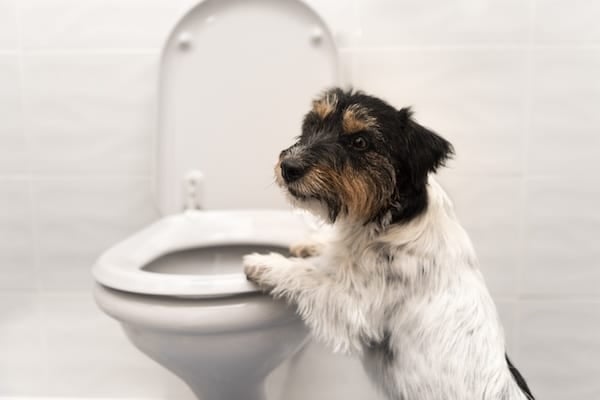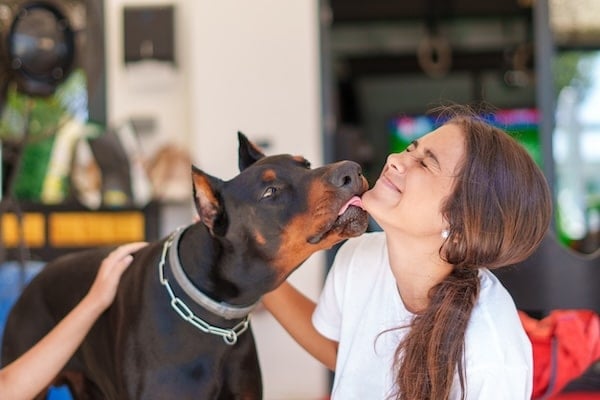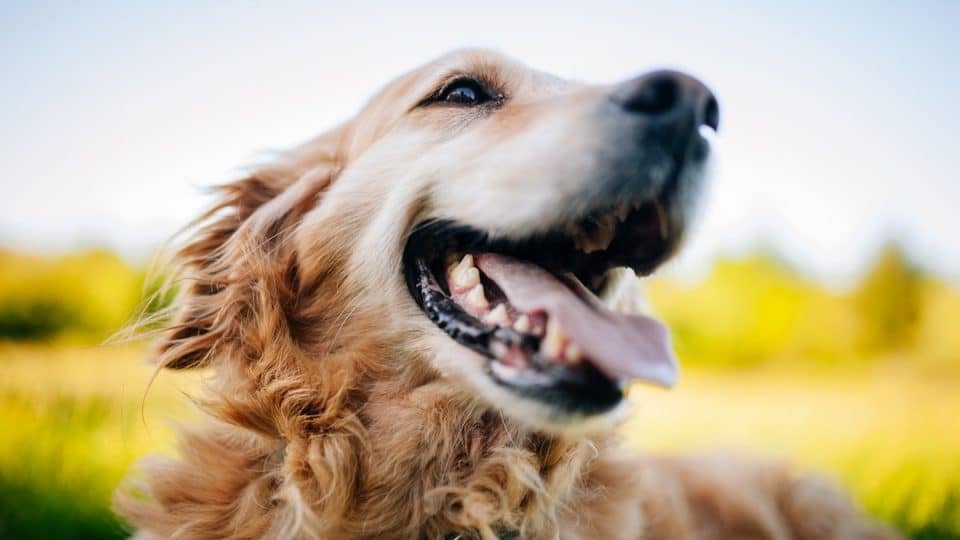- Not a substitute for professional veterinary help.
Is it true that dog mouths are cleaner than humans mouths? The quick answer is no. But then why do some people think they are?
This myth may have stemmed from the idea that dogs don’t seem to pass diseases as easily between each other as people do. Dogs also appear to lick their wounds in a way that helps them heal.
However, our expert, Dr. Jamie Richardson, a veterinarian and Chief Medical Officer at Small Door Veterinary, puts these ideas to rest. “Both human and dog mouths contain bacteria, but neither is inherently cleaner than the other,” she confirms.
In this piece, we’ll explore what science has to say about whether dog mouths are cleaner than ours. We’ll also dive into the details of canine oral hygiene to help you learn how to keep your pup’s mouth as healthy as possible.
Is a Dog’s Mouth Cleaner Than…
It’s hard to imagine your dog’s mouth is particularly clean after you’ve seen them lick themselves or eat from the trash. And yet there’s a widespread notion that dogs have the cleanest mouths in the animal kingdom. We’re here to shed some light on the subject. Let’s start by exploring the cleanliness of a dog’s mouth compared to a human’s, a cat’s, and even a toilet.
Human saliva
We’ve already confirmed that it’s not true that dogs’ mouths are cleaner than humans’. But let’s look at why.
“A dog’s mouth is teeming with bacteria,” says Dr. Richardson, “just like a human’s.” In fact, researchers have identified over 600 types of bacteria in canine mouths and more than 615 types in human mouths.
It’s important to note, however, that the species of bacteria found in dog mouths are largely different from those found in human mouths. In other words, since most of the bacteria in a dog’s mouth prefer canine hosts, they aren’t likely to be harmful to humans when passed through contact with saliva. So directly comparing the two doesn’t make a lot of sense.
Cat saliva
In the same way that a dog’s mouth isn’t cleaner than a human’s, neither is it cleaner than a cat’s. “They just contain different types of bacteria,” Dr. Richards explains. Again, it’s a bit like comparing apples to oranges.
Research into the microbial content of feline saliva is also somewhat limited and inconclusive. Some studies have identified between 249 and 411 bacterial species in cat saliva, while other research suggests cats have similar oral microbial diversity to dogs and humans, with over 600 species.
A toilet
Is a dog’s mouth cleaner than a toilet? Again, a dog’s mouth isn’t necessarily clean, but the average toilet is likely to be dirtier. A 2014 study on public restrooms identified nearly 78,000 unique microbial strains in samples taken from 602 different toilets.
It’s also worth noting that because much of the bacteria found in toilets is of human origin (from human waste), it may be transmitted to humans more easily than bacteria from a dog’s mouth.

K_Thalhofer via iStock
Do Dogs Have Good Mouth Hygiene?
We’ve established that dog mouths aren’t really cleaner than ours, but what part is the cleanest? What about the dirtiest?
“It’s not necessarily a matter of what part of the dog’s mouth is the dirtiest,” points out Dr. Richardson. “It’s more about where the mouth has been and the bacteria that it can be carrying.” Just to be safe, try to avoid getting your dog’s saliva into your own mouth or an open wound, especially if you’re immunocompromised.
Here are some aspects of canine oral hygiene in greater depth.
Bacteria count
According to Dr. Richardson, there are hundreds of different bacterial species in a dog’s mouth based on factors like diet, environment, and oral hygiene. Dogs with dental disease may exhibit a higher concentration of oral bacteria, leading to plaque buildup, bad breath, and eventual damage to the gums and teeth.
Germ transmission
Your dog’s saliva may be full of germs, but the risk you’ll get sick from contact (aka slurpy greetings) is fairly low. Most of the bacteria in dog mouths are not zoonotic, meaning they don’t transfer across species. In other words, you’re less likely to get sick from kissing your dog than from kissing another human. Of course, there are exceptions to the rule—some pathogens can be transmitted to humans more easily than others.
For example, if your dog’s food is contaminated with salmonella or E. coli, they could pass the bacteria on to you. With other zoonotic diseases (like rabies), the risk for transmission is higher if an infected dog bites you than if they lick you. Some of the most common bacterial strains passed through dog bites include Pasteurella canis and Capnocytophaga canimorsus.
Wound healing
It’s true that a dog’s instinct is usually to lick their wounds, and that might have some benefits. Dr. Richardson suggests this could, in part, be because dog saliva contains certain enzymes and proteins that offer mild antibacterial and anti-inflammatory properties. To a certain degree, licking may also promote healing by removing dirt, debris, and dead tissue from the wound site. But it doesn’t mean a dog’s mouth is particularly clean.
Dental diseases
Like humans, dogs are prone to developing dental disease over time. In fact, the same bacterial family, Porphyromonas, causes periodontal disease in both humans and dogs. Dental disease develops when bacteria accumulate on the surfaces of the teeth, forming plaque, which can lead to gingivitis (gum inflammation), bad breath, gum damage, and eventual tooth decay.
Studies show that up to 80-90% of dogs exhibit signs of periodontal disease by three years of age. Regular toothbrushing is the best way to prevent dental disease from developing, though dogs with existing signs may require a more thorough, professional cleaning.

Javier Zayaz via iStock
How To Keep Your Dog’s Mouth Clean
While dog kisses might be cute, Dr. Richardson says they’re not exactly clean, nor should you expect them to be. A healthy mouth will always contain some bacteria. “If a dog licks an open wound or your face, there’s always a risk of infection due to the bacteria present in their saliva,” she says.
The good news is there’s not much risk of transmission if your dog licks unbroken skin, since it won’t absorb much of the saliva. If your dog licks an open wound, however, you should clean it thoroughly and apply disinfectant.
If you develop hives or an itchy rash, you might be allergic to dog saliva and should avoid contact in the future. You may also want to consider training your dog not to lick you. The best strategy is to teach them a new behavior instead of licking, like booping your hand with their nose, and rewarding them generously when they do it.
You can also take actionable steps to keep your dog’s mouth clean, including the following:
- Brushing your dog’s teeth daily using a dog-safe toothbrush and toothpaste
- Using dog mouthwash or dental water additives
- Talking to your veterinarian about dental dog food
- Controlling plaque and tartar buildup with dog dental chews and dental treats
- Keeping up with wellness exams and professional dental cleanings when required
- Considering a pet insurance plan that covers dental
Keeping up with your dog’s oral hygiene isn’t just about keeping their breath fresh and their mouth clean for you. Good dental health helps ensure a better quality of life for your furry family member, too!



